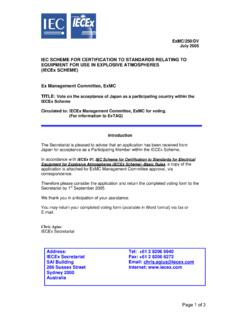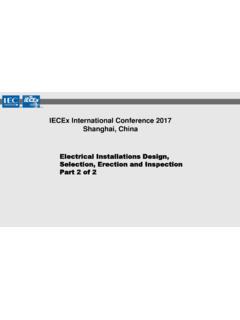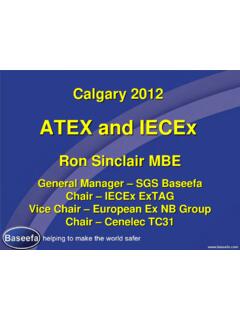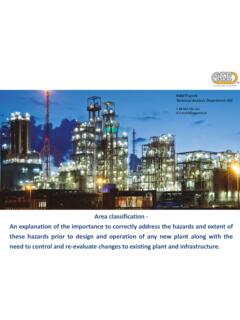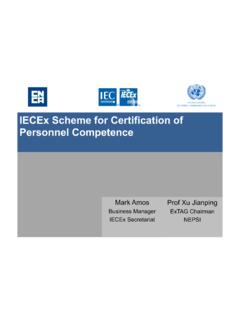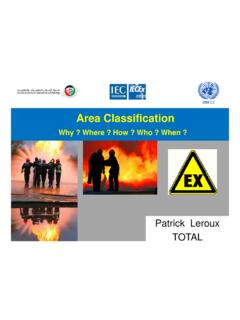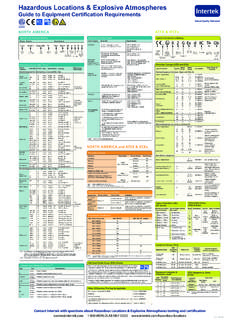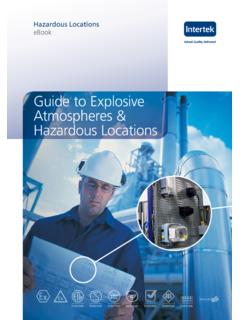Transcription of Hazardous Area Classification - dust atmospheres
1 HazardousArea Classification -dust atmospheres new plant design and operation and re-evaluate changes to existing plant Ireneusz RogalaProgramDust Explosions An Overview, Dust Hazardous area Classification -Basisand Extensions-Role of data preparation, -Data acquisition and verificationExplosion hazards in process safety analysis-co-relations Final conclusionsProgramDusts hazardsAREA Classification -Why?How?What?R2P2 Risk Understanding F x C Risk Evaluating Methods/ StandardsRisk Controling Time / money(resources)IEC 60079-10-2:2015 Standards IEC 60079-10-2:2015 RLVis concerned with the identification and Classification of areas where explosive dust atmospheres and combustible dust layers are present, so asto permit the proper assessment of ignition sources in such , Actualization, Validation. Analysis of consequences Criteriaand standard -values Cost Benefit Analysis & Optimization Safety measures implementation Technical / organizationalRisk communication / safety measures communication Input dataRisk AssassmentRisk reduction measuresOutput data,Risk Communication Scenario probability analysisRiskanalysisSafety standards CriteriaRisk analysis cycle -iterative approachStep by step Procedures of risk analysis H A C work in progress Methods of eliminationDocumentationHazardous Area ClassificationSources of releaseTime and quantitiesSubstances characterization Places / installationsKey parametersStep by step SafetymeasuresapplyingSafety concept.
2 Project Verification /communicationRisk analysisand assessment Probabilityin placeConsequencesIgnitionsourcesIdentifi cationCharacteristicsProcedures of risk analysis Dust ExplosionsDust deposits / layers S e q u e n c e of e v e n t sMixing with airExplosion with its ConsequencesEfficient source of ignition Substances, sources of dustsDust ExplosionsDust deposits / layers S e q u e n c e of e x p l o s i o n sPrimary explosion Explosion with its ConsequencesCloudsof dustSubstances, sources of dustsDust depositsMixing with airExplosion generating cloudsEfficient source of ignition Dust depositsMixing with airExplosion with its ConsequencesEfficient source of ignition Substances characterization Formation of atmosphere Combustibility Source of release Size, Quantities Process conditions Limiting Oxygen Concentration -LOCE ffectiveness of ignition MIT minimum ignition temperature -TCl; Tmax 2/3 xTCl MIE minimum ignition energy SIT self ignition temperature (5 mm dust deposit) -T5mm.
3 Tmax T5mm 750C Electrical ResistivitySubstances characterization Consequences Pmax Kmax Maximum explosion pressure at normal condition Normalized pressure increase rateZones definitionZone 22 Zone 21 Zone20 A Hazardous atmosphere formed by dust cloud in airis not likely to occur in normal operation, and if so then for a short period only, either Accumulations and layers ofcombustible dust are present A Hazardous atmosphere formed by dust cloud in airis likely to occur in normal operation, but not frequentlyand onlyforshort periods layers od combustible dust willin generalbepresent A Hazardous atmosphere formed by dust cloud in air is present: Continuously or For long periods or Frequently Dust layers may be formed Class IIDivision1 Class IIDivision2 Zones definitionZone 22 Zone 21 Zone20 A Hazardous atmosphere formed by dust cloud in air is not likely to occur in normal operation, and if so then for a short period only, either Accumulations and layers of combustible dust are present A Hazardous atmosphere formed by dust cloud in air is likely to occur in normal operation, but not frequently and only for short periods layers od combustible dust will in general be present A Hazardous atmosphere formed by dust cloud in air is present.
4 Continuously or For long periods or Frequently Dust layers may be formed Explosion protection measures preventing and mitigating Preventing explosive dust cloud Releases removing Depositdecreasing Inerting by N2, CO2 and others Water vapour Inerting by inert dust adding Good housekeeping /dust removing Mechanical integrity of installation Water fog Mitigation of primary explosionsPreventing ignition sources Electric devices compliance Non electric devices Hot surfaces Electro static Discharges Smouldering combustion in dust Heat from mechanical impact (metal sparks and hot points)Mitigation Partial Inerting Isolating (making sections) Venting Pressure resistant construction Suppression with automatic systems Good housekeepingArea Classification and other steps connected with, shall be documented Recommendations from relevant codes and standards Assessment of dust dispersion from all sources of release Process parameters, which influence the formation of explosive dust atmosphere and dust layers Operational and maintenance parameters, Housekeeping programsListed all process materials with its propertiesDrawings with type and extent of zones, tables with locations and identification of sources of release / plans and elevationsMethods for maintaining and regularly reviewing the Classification also materials and equipment changes.
5 With distribution listThe reasons for the decisions taken to establish the type and extent of zonesHard copy or electronic version which should include:Area Classification shall be documented Area Classification shall be documented Who can do this work? How it can be done?Owner / Operator employeesOutsourced team expertsUnit Ex 002 - Classification of Hazardous areasWhat competencydothey have?How to buy? Who s opinion is valid? How to cooperate and communicate?Examples -housekeepingRemoves dusts from area -decreases Hazardous area size Removes dusts from area -decreases amount of dust and consequencesGood housekeepingShould be checked to provide information for proper scheduling Should be checked for risk analysis verification New projects and existing installationsDifferences -benchmarking reference dataneed time to verify dataeasy to create good solutionNewExistingprovide verified datamanagement of changeavoid a routine in assessmentExamples -process analysis SummaryMultidimensional task for very well prepared expertsWell recognized and clear IEC Standard IEC 60079-10-2:2015 Hazardous Area Classification for explosive dusts Significant influence on spending's for safety measuresThank youIreneusz Rogala
